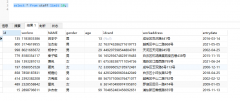Which is faster — INSTR or LIKE?(哪个更快——INSTR 还是 LIKE?)
问题描述
如果您的目标是测试某个字符串是否存在于 MySQL 列(类型为varchar"、text"、blob"等)中,以下哪个更快/更有效/更好用,以及为什么?
If your goal is to test if a string exists in a MySQL column (of type 'varchar', 'text', 'blob', etc) which of the following is faster / more efficient / better to use, and why?
或者,是否有其他方法可以胜过其中任何一个?
Or, is there some other method that tops either of these?
INSTR( columnname, 'mystring' ) > 0
对比
columnname LIKE '%mystring%'
推荐答案
FULLTEXT 搜索绝对会更快,正如 kibibu 在上面的评论中指出的那样.
FULLTEXT searches are absolutely going to be faster, as kibibu noted in the comments above.
不过:
mysql> select COUNT(ID) FROM table WHERE INSTR(Name,'search') > 0;
+-----------+
| COUNT(ID) |
+-----------+
| 40735 |
+-----------+
1 row in set (5.54 sec)
mysql> select COUNT(ID) FROM table WHERE Name LIKE '%search%';
+-----------+
| COUNT(ID) |
+-----------+
| 40735 |
+-----------+
1 row in set (5.54 sec)
在我的测试中,它们的表现完全相同.它们都不区分大小写,并且通常执行全表扫描,这是处理高性能 MySQL 时的一般禁忌.
In my tests, they perform exactly the same. They are both case-insensitive, and generally they perform full-table scans, a general no-no when dealing with high-performance MySQL.
除非您对索引列进行前缀搜索:
Unless you are doing a prefix search on an indexed column:
mysql> select COUNT(ID) FROM table WHERE Name LIKE 'search%';
+-----------+
| COUNT(ID) |
+-----------+
| 7 |
+-----------+
1 row in set (3.88 sec)
在这种情况下,只有后缀通配符的 LIKE 要快得多.
In which case, the LIKE with only a suffix wildcard is much faster.
这篇关于哪个更快——INSTR 还是 LIKE?的文章就介绍到这了,希望我们推荐的答案对大家有所帮助,也希望大家多多支持编程学习网!
本文标题为:哪个更快——INSTR 还是 LIKE?


基础教程推荐
- 如何在 CakePHP 3 中实现 INSERT ON DUPLICATE KEY UPDATE aka upsert? 2021-01-01
- while 在触发器内循环以遍历 sql 中表的所有列 2022-01-01
- CHECKSUM 和 CHECKSUM_AGG:算法是什么? 2021-01-01
- MySQL 5.7参照时间戳生成日期列 2022-01-01
- 带有WHERE子句的LAG()函数 2022-01-01
- 带更新的 sqlite CTE 2022-01-01
- 从字符串 TSQL 中获取数字 2021-01-01
- ORA-01830:日期格式图片在转换整个输入字符串之前结束/选择日期查询的总和 2021-01-01
- MySQL根据从其他列分组的值,对两列之间的值进行求和 2022-01-01
- 使用 VBS 和注册表来确定安装了哪个版本和 32 位 2021-01-01

















